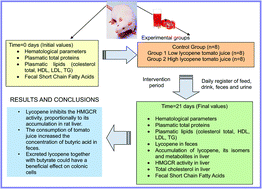Effect of tomato juice consumption on the plasmatic lipid profile, hepatic HMGCR activity, and fecal short chain fatty acid content of rats
Abstract
The aims of the present study were to ascertain, indirectly, the prebiotic role of tomato juice, by analyzing its effect on the content of short chain fatty acids (SCFA) in feces of rats, and to determine the plausible mechanisms related to the hypocholesterolemic effects of tomato juice and lycopene, evaluating the activity of hepatic HMGCR and the formation of propionic acid. Two commercially available tomato juices with differing contents of lycopene (low and high lycopene contents: Llyc and Hlyc tomato juices) were used. Sprague-Dawley male rats were randomly divided into three experimental groups (n = 8): control group, normal diet and water; group 1, normal diet and Llyc tomato juice; and group 2, normal diet and Hlyc tomato juice, which were fed ad libitum for three weeks. Feces were collected at the beginning and the end of the study to determine SCFA, and blood and liver were obtained (after sacrificing the animals) to analyze the lipid plasmatic parameters and the HMGCR activity and total cholesterol, respectively. No significant differences were observed in the plasmatic parameters, except that HDL-cholesterol increased significantly after consumption of both tomato juices. Lycopene was accumulated in the liver in proportion to the amount ingested, and was observed to have an inhibitory effect on the HMGCR enzyme, according to the amount of lycopene in the liver. In relation to the SCFA in feces, no differences were observed in acetate and propionate after the consumption of tomato juice, but a significant increase in butyrate was observed in group 2 after the intake of Hlyc tomato juice. The content of this carboxylic acid together with excreted lycopene in feces could have a beneficial effect on colonic cells.


 Please wait while we load your content...
Please wait while we load your content...